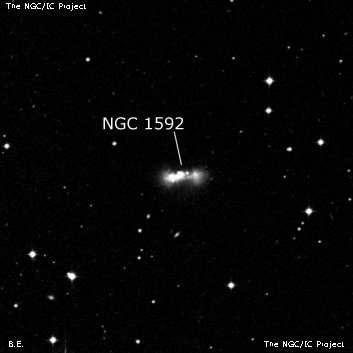
John Herschel discovered NGC 1592 = h2645 on 29 Dec 1834 and recorded "vF; vS." He only observed this object on one sweep and the declination is given as uncertain. There is nothing at his position and Herbert Howe reported in 1898 that "in the place given for this I found only small stars. 1591, near by, was observed".
RC3 identifies ESO 421-002 as NGC 1592, although this galaxy is 27' S (correct in RA) of Herschel's position. Given the uncertainly in his declination, this seems a likely candidate. Neither MCG nor ESO label ESO 421-002 as NGC 1592. RNGC classifies this number nonexistent.
400/500mm - 17.5" (2/3/03): faint, fairly small, elongated 2:1 E-W, 0.8'x0.4', fairly low even surface brightness. At moments, there appeared to be an extension or companion attached on the following side. On the DSS, this is an unusual (multiple?) galaxy (PGC 15285 and 15292) with two off-center knots or condensations, one on the east end! A perfect parallelogram of stars with sides 3'x1' lies 5' SE (brightest stars mag 10 on the south side).
Notes by Steve Gottlieb